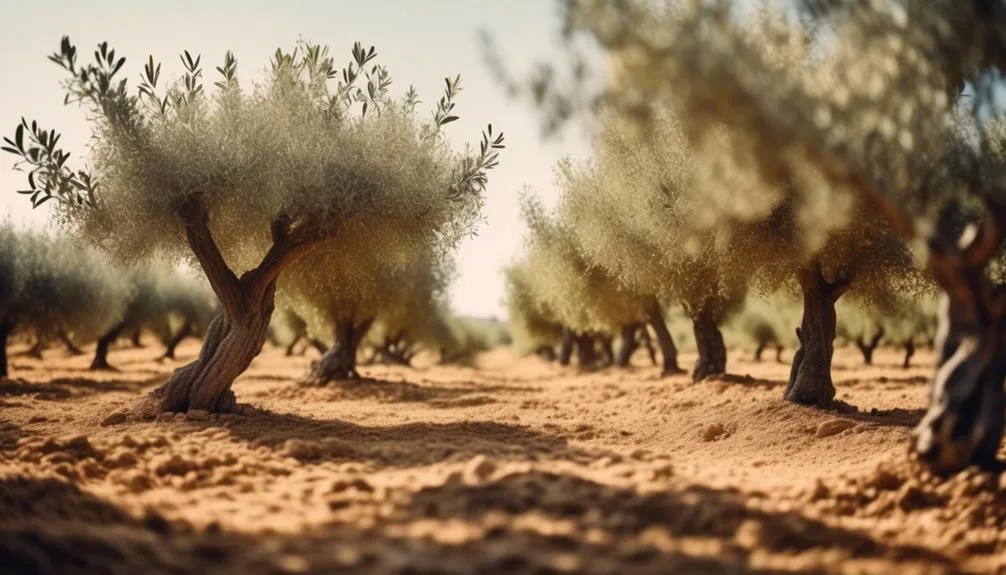When it comes to planting olive trees, the location is key. The soil, climate, sunlight, and watering all play a part in the trees' yield.
In this discussion, we'll cover the essential aspects of planting olive trees for the best yield. We'll help you understand what you need to consider when setting up an olive orchard for success.
Key Takeaways
- Olive trees thrive in well-draining soil and require a Mediterranean climate for optimal growth and yield.
- Adequate sunlight and proper irrigation are essential for the successful cultivation of olive trees.
- Planting olive trees with adequate spacing and at the correct depth promotes healthy root development and maximizes sunlight exposure.
- Regular pruning, proper fertilization, and consistent watering are important for maintaining the health and productivity of olive trees.
Soil and Climate Requirements
To achieve optimal yield when planting olive trees, it's crucial to select a location with well-draining soil and a Mediterranean climate. The soil should have good fertility, as this is essential for the healthy growth of olive trees.
When it comes to irrigation methods, olive trees require a careful balance. They're drought-tolerant, but during the fruit development stage, they need sufficient moisture. Drip irrigation is a popular choice for olive trees, as it provides controlled and efficient watering directly to the roots.
Additionally, the Mediterranean climate plays a key role in the success of olive trees. The warm, dry summers and mild, wet winters create an ideal environment for olive cultivation. Choosing the right location with these soil and climate requirements is fundamental to ensuring a bountiful olive harvest.
Sunlight and Watering Needs
When considering the optimal placement for your olive trees, it's important to factor in not only the soil and climate requirements but also the sunlight and watering needs that will directly impact their growth and yield.
Proper irrigation methods and drainage solutions are crucial for olive trees. Depending on your specific climate, you may need to consider drip irrigation or other water-efficient methods to ensure adequate moisture without waterlogging the soil.
Additionally, managing shade and tree orientation is essential. Olive trees require plenty of sunlight, so it's important to plan for adequate sun exposure while also considering the potential for providing some shade during extreme heat.
Proper tree orientation can help maximize sunlight exposure throughout the day, promoting healthy growth and ultimately leading to a better yield.
Spacing and Planting Techniques
Considering the layout of your orchard and the growth potential of olive trees, it's essential to carefully plan the spacing and planting techniques for optimal yield and tree health. Proper spacing and planting can significantly impact root development and overall tree productivity. Here are some key points to keep in mind:
- Root development: Adequate spacing between trees promotes healthy root development and prevents overcrowding, which can lead to competition for water and nutrients.
- Tree spacing: Opt for a spacing of 20-30 feet between trees to allow ample room for growth and ensure that each tree receives sufficient sunlight and airflow.
- Planting depth: When planting, ensure that the root ball is level with the soil surface to facilitate proper establishment and prevent waterlogging.
- Row orientation: Consider the orientation of rows to maximize sunlight exposure and facilitate efficient irrigation and maintenance.
- Planting techniques: Explore different planting techniques such as hedgerow or traditional spacing to determine the most suitable approach for your orchard.
Pruning and Maintenance Tips
For optimal olive tree health and yield, mastering pruning and maintenance is crucial to ensure sustained productivity and longevity.
Understanding the growth patterns of olive trees is essential for effective pruning. Regularly shaping the tree by removing dead or damaged branches and maintaining an open center will promote healthy growth and facilitate ease of harvesting. Pruning should be done during the tree's dormant season to avoid interfering with fruit production.
In terms of maintenance, proper fertilization and watering are key. Olive trees thrive in well-drained soil and benefit from a balanced fertilizer. Watering should be consistent, especially during dry periods, but overwatering should be avoided to prevent root rot.
Pest and Disease Management
To effectively manage pests and diseases in your olive trees, it's essential to regularly inspect the trees for early signs of infestation or infection. By staying proactive, you can implement effective pest and disease control measures to ensure the health and productivity of your olive trees.
Here are some key strategies to consider:
- Integrated Pest Management: Utilize a combination of cultural, biological, and chemical controls to manage pest populations.
- Disease Control: Implement proper sanitation and use disease-resistant olive tree varieties to minimize the risk of infections.
- Natural Predators: Encourage the presence of beneficial insects and birds that feed on olive tree pests.
- Resistant Varieties: Select olive tree cultivars known for their resistance to common pests and diseases.
- Regular Monitoring: Keep a close eye on your olive trees to identify any pest or disease issues early on for prompt intervention.
Conclusion
In nurturing your olive trees with the right soil, sunlight, and care, you're set to enjoy a bountiful harvest.
Stay vigilant against pests and diseases, and tend to your trees with dedication.
Here's to a fruitful planting and a rewarding harvest ahead!

